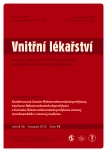Is polycystic ovary syndrome associated with autoimmune thyroiditis?
Authors:
J. Petríková; J. Figurová; I. Dravecká; I. Lazúrová
Authors‘ workplace:
I. interná klinika Lekárskej fakulty UPJŠ a UN L. Pasteura Košice, Slovenská republika, prednostka prof. MUDr. Ivica Lazúrová, CSc.
Published in:
Vnitř Lék 2012; 58(11): 830-833
Category:
Original Contributions
Overview
Introduction:
Polycystic ovary syndrome (PCOS) is one of the most common endocrinopathies in women of fertile age and lately there is a discussion about its possible association with autoimmune diseases.
The aim of the study was to examine incidence of autoimmune thyreoiditis (AIT) in PCOS women. Patients and methods: 64 PCOS patients were enrolled and 68 healthy menstruating women served as controls. All subjects were examined for thyrotropin (TSH), free thyroxin (fT4) and the presence as well as titers of antithyroid antibodies aTG (anti-thyreoglobulin) and aTPO (anti-thyreoperoxidase).
Results:
There was no difference between PCOS and controls in average TSH levels (2.37 ± 1.46 mIU/l vs 2.37 ± 1.46 mIU/l) (p = 0.953), and fT4 levels (16.36 ± 5.34 pmol/l vs 16.49 ± 2.32 pmol/l) (p = 0.852). Autoantibodies titers were also non-significant aTG (53.09 ± 157.07 IU/ml vs 29.8 ± 100.77 IU/ml, p = 0.386) and aTPO (59.74 ± 149.03 IU/ml vs 45 ± 204.77 IU/ml, p = 0.805). However, PCOS women had significantly higher prevalence of aTPO (18.75 vs 7.35%, p = 0.045). On the other hand, the overall prevalence of AIT was similar in both groups.
Conclusion:
Our results show PCOS patients have slightly but significantly higher positivity of aTPO antibodies but the prevalence of AIT was insignificant.
Key words:
PCOS – autoimmunity – autoimmune thyreoiditis – autoantibodies
Sources
1. Fauser BC, Tarlatzis BC, Rebar RW et al. Consensus on women’s health aspects of polycystic ovary syndrome (PCOS): the Amsterdam ESHRE/ASRM-Sponsored 3rd PCOS Consensus Workshop Group. Fertil Steril 2012; 97: 28–38.
2. Janssen OE, Mehlmauer N, Hahn S et al. High prevalence of autoimmune thyroiditis in patients with polycystic ovary syndrome. Eur J Endocrinol 2004; 150: 363–369.
3. Carretti N, Prendin G. Relations between thyroid and ovarian function: estrogenism and basal metabolism. Attualita di Ostetricia e Ginecologia 1968; 1: 111–120.
4. Goi R, Matsuda M, Maekawa H et al. Two cases of Hashimoto’s thyroiditis with transient hypothyroidism. Intern Med 1992; 31: 64–68.
5. Anaforoglu I, Topbas M, Algun E. Relative associations of polycystic ovarian syndrome vs metabolic syndrome with thyroid function, volume, nodularity and autoimmunity. J Endocrinol Invest 2011; 34: e259–e264.
6. Wakim AN, Polizotto SL, Burholt DR. Augmentation by thyroxine of human granulosa cell gonadotrophin-induced steroidogenesis. Hum Reprod 1995; 10: 2845–2848.
7. Muderris II, Boztosun A, Oner G et al. Effect of thyroid hormone replacement therapy on ovarian volume and androgen hormones in patients with untreated primary hypothyroidism. Ann Saudi Med 2011; 2: 145–151.
8. The Rotterdam ESHRE/ASRM-sponsored PCOS workshop group: Revised 2003 consensus on diagnostic criteria and long-term health risks related to polycystic ovary syndrome (PCOS). Hum Reprod 2004; 19: 41–47.
9. Wu X, Zhang Z, Su Y. Functional states of pituitary-ovary, -adrenal and -thyroid axes in women with polycystic ovarian syndrome. Zhonghua Fu Chan Ke Za Zhi 1998; 33: 153–156.
10. Zironi C, Pantaleoni M, Zizzo G et al. Evaluation of dopaminergic activity of the hypothalamus in patients with polycystic ovarian syndrome. Minerva Ginecol 1991; 43: 443–447.
11. Tudose TI, Zelenetskaia VS, Kozlov GI et al. Lactotropic and thyrotropic functions of the hypophysis in polycystic ovary syndrome. Probl Endokrinol 1986; 32: 3–7.
12. Duignan NM. Polycystic ovarian disease. Br J Obstet Gynaecol 1976; 83: 593–602.
13. Gulekli B, Turhan NO, Senoz S et al. Endocrinological, ultrasonographic and clinical findings in adolescent and adult polycystic ovary patients: a comparative study. Gynecol Endocrinol 1993; 7: 273–277.
14. Bussen S, Steck T, Dietl J. Increased prevalence of thyroid antibodies in euthyroid women with a history of recurrent in-vitro fertilization failure. Human Reproduction 2000; 15: 545–548.
15. Ott J, Aust S, Kurz C et al. Elevated antithyroid peroxidase antibodies indicating Hashimoto’s thyroiditis are associated with the treatment response in infertile women with polycystic ovary syndrome. Fertil Steril 2010; 94: 2895–2897.
16. Gawlik A, Gawlik T, Januszek-Trzciakowska A et al. Incidence and dynamics of thyroid dysfunction and thyroid autoimmunity in girls with Turner’ssyndrome: a long-term follow-up study. Horm Res Paediatr 2011; 76: 314–320.
17. Gleicher N, El-Roeiy A, Confino E et al. Is endometriosis an autoimmune disease? Obstet Gynecol 1987; 70: 115–122.
18. Sridhar GR, Nagamani G. Hypothyroidism presenting with polycystic ovary syndrome.J Assoc Physicians India 1993; 41: 88–90.
19. Ganie MA, Marwaha RK, Aggarwal R et al. High prevalence of polycystic ovary syndrome characteristics in girls with euthyroid chronic lymphocytic thyroiditis: a case-control study. Eur J Endocrinol 2010; 162: 1117–1122.
20. Kachuei M, Jafari F, Kachuei A et al. Prevalence of autoimmune thyroiditis in patients with polycystic ovary syndrome. Arch Gynecol Obstet 2012; 285: 853–856.
21. Jung JH, Hahm JR, Jung TS et al. A 27-year--old woman diagnosed as polycystic ovary syndrome associated with Graves’ disease. Intern Med 2011; 50: 2185–2189.
Labels
Diabetology Endocrinology Internal medicineArticle was published in
Internal Medicine

2012 Issue 11
Most read in this issue
- Coronary-subclavian steal syndrome, a complication following surgical revascularization of myocardium
- Vitamin D metabolism and current options for therapeutic activation of vitamin D receptor in patients with chronic kidney disease or renal failure
- Left ventricular myxoma – an unexpected cause of dyspnoea and fever in a young patient
- Carcinoid and its cardiac manifestation
